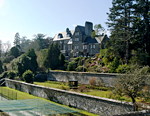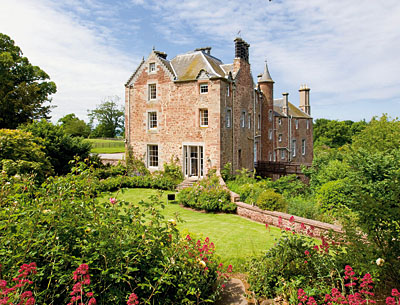Four exceptional country estates for sale in Scotland
Four wonderful country estates have burst onto the market in Scotland, including a rare £25m gem


Today sees the launch onto the open market of that rarest of Scottish birds-a substantial residential and sporting estate with a highly profitable farming enterprise, overlooking the sweeping East Lothian coast and a mere 31 miles from Edinburgh. For sale as a whole through Knight Frank (0131-222 9600) and Strutt & Parker (0131-226 2500), at a record guide price of ‘offers in the region of £25 million', the 2,463-acre Spott estate near sunny Dunbar combines a mouth-watering array of property and sporting assets.
They include an impeccably restored historic mansion house; a substantial farmhouse; 14 cottages; modern and traditional farm buildings; a high-powered, 1,779-acre, mixed arable, organic-beef and sheep unit carrying a Single Payment entitlement of €267,094 in 2009/10; 356 acres of woodland; and rolling terrain offering superb driven partridge and pheasant shooting, plus duck-flighting and roe-deer stalking.
Spott House (pictured) has been home to the owners of the estate since the 13th century, when Elias de Sprot swore fealty to King Edward I of England. Spott also holds the dubious distinction of playing host to the last executions carried out during the Scottish witch hunts of the 17th and 18th centuries. At various times, the estate was part of ancestral lands owned by eminent local families, such as the Humes, the Douglasses, the Murrays and the Hays of Yester. Oliver Cromwell is reputed to have stayed at the house during the second Battle of Dunbar in 1650.

In 1830, the estate's new owner, James Sprot, commissioned Scottish baronial architect William Burn to upgrade and extend the existing mid-17th-century tower house. The mansion was to remain in the Sprot family until 1947, when it was sold to Sir James Hope. Spott's sporting current owner, Danish indus-trialist Lars Foghsgaard, bought the estate from the Lawrie family in 2000, since when he has completely restored the house and its buildings, and progressively expanded and improved the original 600-acre land holding. Now, following the arrival of his first grand-children, Mr Foghsgaard has decided to move his family back to their native Denmark.
Imposing Spott House, listed Category B, stands on high ground sheltered by towering trees, looking out over easily maintained gardens, grounds and rolling farmland to the North Sea. The house has well-proportioned rooms on four floors, including three fine reception rooms, a state-of-the-art dining room/kitchen, nine bedrooms, eight bathrooms and a self-contained staff flat; the basement houses cellars, a gun room, a mud room, a trophy room, a gallery and a billiards room.
The estate's 14 other houses and cottages are of traditional construction, most of them already renovated. The largest is Brunt Farmhouse, an appealing stone farmhouse with three reception rooms and seven bedrooms, which stands at the heart of what used to be Brunt Farm, on the south side of the estate; this is currently used for holiday lets and shooting parties. Full planning consent was granted in July 2006 (expiring July 2011) to convert the traditional steading at Brunt into 11 houses and two flats. There's also planning consent, expiring in March 2010, to convert the former laundry buildings into a swimming-pool complex with leisure facilities.
The farmland at Spott is mostly top-quality arable, producing high yields of wheat, barley and oilseed rape; parts of the farm are also suitable for potato-growing. The fields are large and free-draining-ideally suited to modern farming techniques. Spott's 214 acres of pasture are grazed by an organic herd of 70 suckler cows and an organic flock of 400 cross-bred ewes. The practical sits happily beside the sporting on this forward-thinking estate, where the deep Brunt gulley, for example, provides both sheltered grazing for cattle and a haven for some wonderful high-flying birds.
Exquisite houses, the beauty of Nature, and how to get the most from your life, straight to your inbox.
In pursuit of his endless quest to improve farm profitability, the estate's dynamic farm manager recently found a new outlet for the farm's organic meat through a local farm shop, creating an estate brand called Spott the Difference. A message that will no doubt be hammered home in the coming weeks by selling agents John Coleman of Knight Frank and Andrew Rettie of Strutt & Parker, whose job it is to find a buyer for this thriving country estate ‘the likes of which has not been seen on the Scottish market in years', says Mr Coleman.
But Spott isn't the only Scottish gem to hit the market early this year. Over on the west coast, Strutt & Parker invite ‘offers over £1.75m' for Arisaig House in Inverness-shire, a magnificent Scottish mansion built in 1864 to the designs of Victorian architect Philip Webb, dubbed ‘the father of Arts-and-Crafts architecture'.
The house, listed Category B, which figured in Marcus Binney's book In Search of the Perfect House: 500 of the Best Buildings in Britain and Ireland (2007), was commissioned by Francis Dukinfield Palmer-Astley, who bought the surrounding 18,000-acre estate in 1848. Arisaig House was badly damaged by fire in 1935, and largely reconstructed in 1937, to plans by the Scottish architect Ian Hamilton. Requisitioned by the army during the Second World War, Arisaig was the training headquarters of Churchill's Special Operations Executive (SOE).
The house stands in 18 acres of gardens and woodland on a site of extraordinary natural beauty, totally sheltered from the north and with spectacular views to the south and east of sea, loch and mountain-this is West Highland scenery at its most breathtaking. Modernised throughout in 1981, the 15-bedroom main house is set around a traditional courtyard, and has some notable rooms, including an Art Nouveau dining room and a drawing room with an Italianate vaulted ceiling. An ornately carved oak staircase portrays various game birds and animals. The sale includes a successful holiday-letting business of three apartments and four estate cottages, with direct access to the sea via a private jetty.
Country Life is unlike any other magazine: the only glossy weekly on the newsstand and the only magazine that has been guest-edited by His Majesty The King not once, but twice. It is a celebration of modern rural life and all its diverse joys and pleasures — that was first published in Queen Victoria's Diamond Jubilee year. Our eclectic mixture of witty and informative content — from the most up-to-date property news and commentary and a coveted glimpse inside some of the UK's best houses and gardens, to gardening, the arts and interior design, written by experts in their field — still cannot be found in print or online, anywhere else.
-
 Picture round: Guess the animal in today's Country Life Quiz of the Day, November 6, 2025
Picture round: Guess the animal in today's Country Life Quiz of the Day, November 6, 2025In today's quiz we're asking you to guess the names of these lesser-known animals.
By Country Life Published
-
 Bunny Mellon: The Truman Capote ‘Swan’, muse and horticulturalist whose creations for The White House were recently lost forever
Bunny Mellon: The Truman Capote ‘Swan’, muse and horticulturalist whose creations for The White House were recently lost foreverAs Tiffany & Co. pay homage to Bunny Mellon with a new Bird on a Rock collection, Owen Holmes takes a look at the most iconic garden designs of this heiress-horticulturist, from her Virginia estate to the White House to Versailles.
By Owen Holmes Published

